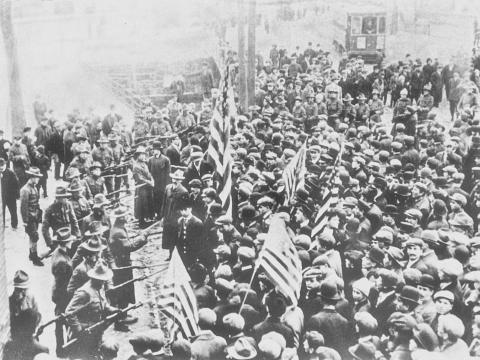The Bay Area Food Mart Campaign began in 2009 and concluded in 2015. It was an experiment in reviving some of the IWW's essential revolutionary traditions in the context of the 21st century.
Fellow Workers:
1. Purpose
The Bay Area Food Mart Campaign began in 2009 and concluded in 2015. It was an experiment in reviving some of the IWW's essential revolutionary traditions in the context of the 21st century. The hope was to build off the successes of our union's recent organizing methods while aiming to surpass their limitations. A paper titled Wobblyism was written earlier by members of the committee on this topic. Like any experiment, ours yielded positive and negative results that organizers would do well to learn from.
This memo is intended to be a brief, rough summary, preceding a more in-depth debriefing and analysis of the campaign's advancements, challenges, and limitations, along with critical questions that we hope the IWW will address in the near future.
2. Why Whole Foods?
Small group of workers were already self-organizing.
WFM would be particularly vulnerable to public pressure.
Workers at store tended to stay longer than in many other food/retail workplaces, and were assessed to be more likely to invest in workplace struggle.
Store was excellent cross-section of Bay Area working class (gender, race, language, background)
Many FM workers drawn to employer because of previous interest in social justice, however vague or contradictory
Eventual move down supply chain was likely, given nearby location of regional distribution center
3. Advancements
In our full report we hope to discuss goal identification and measurement for revolutionary organizing. Here we focus on our key foundational victories we believe “advance” long term revolutionary organization.
Relationship Building: Nuanced and comprehensive political recruitment and membership development program.
Methodology: combining political co-education, strategic point-of-production organizing.
Organization: Multi-faceted and adaptable proletarian formation, avoiding taking on service union function or activist tendencies.
WFM introduces regional policies for wages and schedules
Mission: Concerted effort to identify and evaluate revolutionary aims, principles, and processes based on explicit points of unity, continuing education, and communication with other IWW’s and allies.
Through constructing, testing, reflecting on, and reevaluating a protocol for committee membership, the Bay Area Food Mart Committee developed a distinct rubric for committee member recruitment and development. This rubric, suited to the demands of the campaign, was designed to discern which coworkers should be prioritized for recruitment and which individuals from outside the workplace should be asked to salt in. After a few months of earning trust, preconfigured 1-on-1’s, discussing the campaign, assigning tasks and assessing follow-through, as well as establishing expectations for the committee, an invitation to participate in meetings would be extended. Committee meetings were used as forums to impart aspects of the OT 101 curriculum and provide revolutionary education on political economy. All of this facilitated the creation of a tight, high-functioning organizing committee that engaged in sober assessments of strategy with an understanding of the context in which the campaign was operating.
4. Challenges
In our full report we will also try to locate immediate challenges within the scope of a long term revolutionary focus. Below are some critical obstacles we faced.
Low level of class struggle placed objective limitations on campaign's goals and achievements.
Multiple language barriers, only partially overcome with Spanish speakers
Social and cultural obstacles to recruitment and leadership development.
Leadership development uneven for many complex reasons
Organization evaporated shortly after going public. Life events and stress are key reasons.
5. Key Reflections
The height of unionism in practice was the underground period 2011-2014. We established and maintained a fighting union as defined by Solidarity Unionism, Wobblyism, and NLRA Sec 7(a) for at least three years, albeit underground. Could this inform an evolving model of IWW unionism for today, already practiced in some ways by Box Mart?
Mainstream liberal politics was widely internalized among Food Mart workers, and was even present within the committee. This held back political development of co-workers and muddled the position of the IWW.
Deprived of more substantial resources, IWW organizers sacrifice huge pieces of their lives to being successful organizers. This invites mental, physical and other kinds of health challenges that are detrimental to the individual as well as to the organization.
6. Questions that Remain
Is the union campaign organizing framework, especially during low periods of struggle, an effective method of advancing towards communism? Why? And how would we know? How do we currently measure success, and how should we going forward?
Is IWW organizing only valid/recognized if an effort goes "public"? What is the importance of going public in the bigger picture of the IWW? Is this the only way we can promote our vision and unionism to the world? Is unionism underground any less or more unionism?
Is IWW unionism only affirmed through obtaining a majority of a workplace? If so, what constitutes involvement of the majority, and what should the relationship of this majority be to a necessarily minority core of IWWs in our time?





Comments
Interesting, thanks for the
Interesting, thanks for the share. From an outsiders fast read, seems to ask more questions then provides answers Unless, of course, written for an internal audience and understood subtexts
are there any good accounts
are there any good accounts of dealing with the stress of workplace organizing, historical or contemporary? or is the context too different?
syndicalist
syndicalist
It was shared publicly on their blog. I think it was meant to provoke discussion on those questions for sure.
I have some thoughts about
I have some thoughts about how the union can more effectively organize. Will hopefully publish soon. Any chance anyone involved with this campaign will publish more info on what it was like? Longer stuff?